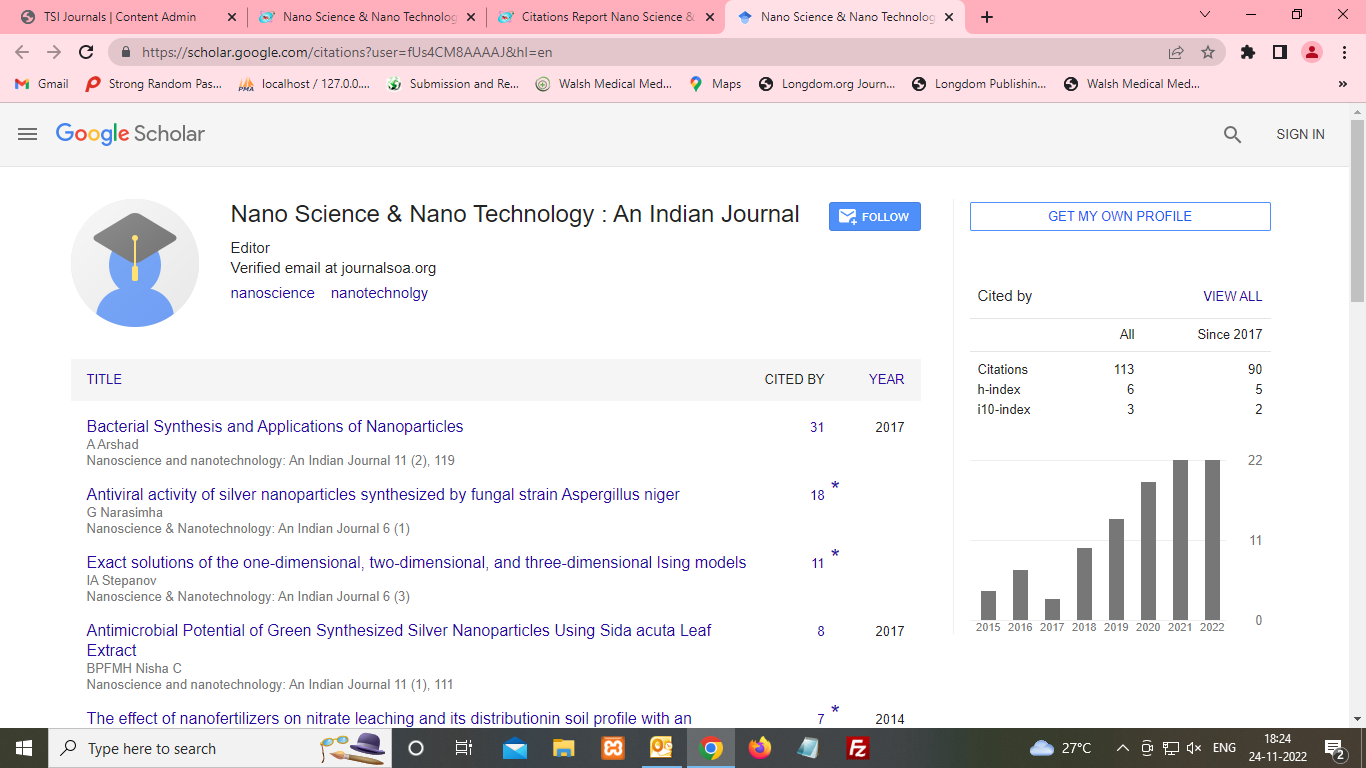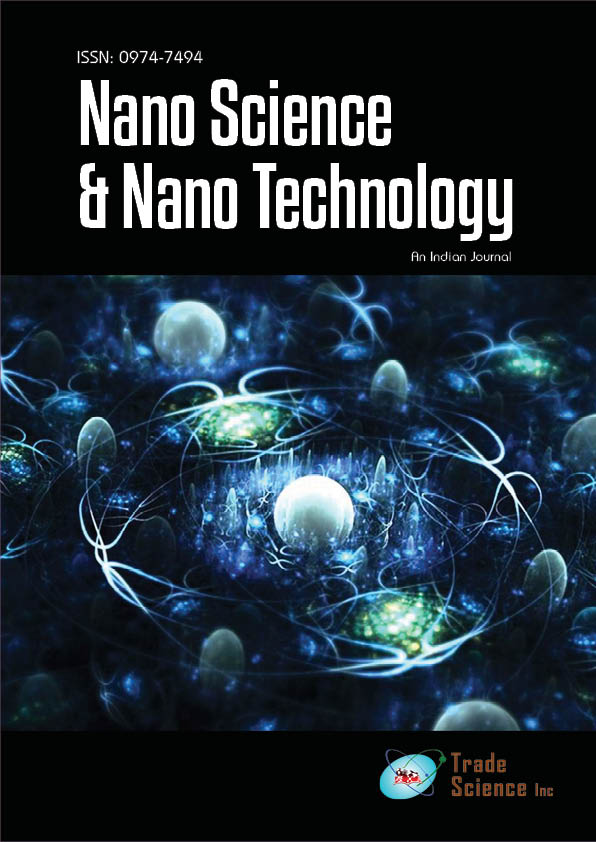Current opinion
, Volume: 16( 1) DOI: DOI: 10.37532/0974-7494.2022.16(1)Properties, Use, and Toxicity of Nanoparticles
- *Correspondence:
- Kyle Simpson
Editorial Office, Nanoscience & Nanotechnology: An Indian Journal, UK
E-mail:info@tsijournals.com
Received date: January 02, 2022, Manuscript No. tsnsnt-22-64826; Editor assigned: January 04, 2022, PreQC No. tsnsnt-22- 64826 (PQ); Reviewed: January 21, 2022, 2022, QC No. tsnsnt-22-64826 (Q); Revised: January 25, 2022, Manuscript No. tsnsnt22-64826 (R); Published: January 29, 2022, DOI: 10.37532/ 0974-7419.2022.16(1).141
Citation:Simpson K. Properties, Use, and Toxicity of Nanoparticles.Nano Tech Nano Sci Ind J. 2022;16(1):141.
Abstract
Nanotechnology has been studied since the nineteenth century. Since Nobel Laureate Richard P. Feynman introduced the term "nanotechnology" in his well-known 1959 speech "There's Plenty of Room at the Bottom, several groundbreaking advancements in the field of nanotechnology have occurred. At the nanoscale, nanotechnology createda variety of materials. Nanoparticles are a broad category of materials that comprise particulate compounds with a minimum diameter of 100 nm. These materials can be 0D, 1D, 2D, or 3D depending on the overall form.
Introduction
Nanotechnology has been studied since the nineteenth century. Since Nobel Laureate Richard P. Feynman introduced the term "nanotechnology" in his well-known 1959 speech "There's Plenty of Room at the Bottom, several groundbreaking advancements in the field of nanotechnology have occurred. At the nanoscale, nanotechnology createda variety of materials. Nanoparticles are a broad category of materials that comprise particulate compounds with a minimum diameter of 100 nm. These materials can be 0D, 1D, 2D, or 3D depending on the overall form.
Characteristics of nanoparticles
Analysts are having trouble determining the physicochemical qualities of nanoparticles and looking into their structure and functional links. Their ability to fully explore the nanoscale realm is a major limitation: Different depiction tactics are based on different real characteristics, resulting in a half-baked image of nanoparticle attributes. The purposeful quantities of nanoparticles can be directly influenced by the representation approaches. Nanoparticles are utilized in a variety of preparations, including micelles, metal (oxide), and synthetic polymers.
Classification of NPs
Depending on their shape, size, and chemical characteristics, NPs are classified into several groups. Some of the most well-known classes of NPs are listed below, based on physical and chemical features.
Carbon-based Nps
Carbon Nanotubes (CNTs) and fullerenes are two primary groups of carbon-based NPs.
Metal NPs
Metal NPs are produced entirely of metal precursors. These NPs have unique optoelectrical features due to their well-known localized surface plasmon resonance (LSPR) characteristics.
Ceramic NPs
Ceramic NPs are inorganic nonmetallic solids that are made by heating and cooling. Amorphous, porous, and hollow shapes are all possible.
Semiconductors NPs
Because semiconductor NPs have large bandgaps, bandgap tuning caused dramatic changes in their characteristics. As a result, they're crucial components in photocatalysis and electrical devices.
Liquid-based NPs
These NPs have lipid moieties and can be used in biological applications. A lipid NP is typically spherical, with a diameter ranging from 10nm to 1000 nm
Properties of NPs
Electronic and optical properties: The optical and electrical characteristics of NPs are much more intertwined. Noble metal NPs, for example, have size-dependent optical characteristics and a significant UV-visible extinction band that is absent from the bulk metal's spectra. This excitation band is known as the localized surface plasma resonance and occurs when the incident photon frequency is constant with the collective excitation of the conduction electrons. The wavelength selection absorption caused by LSPR excitation has an extraordinarily large molar excitation coefficient resonance.
Magnetic properties: Investigators from a diverse variety of fields are interested in magnetic Nps, including heterogeneous and homogeneous catalysis, biomedicine, magnetic fluids, data storage, Magnetic Resonance Imaging (MRI), and environmental remediation such as water purification.
Mechanical properties: To determine the actual mechanical nature of NPs, many mechanical characteristics like as elastic modulus, hardness, stress and strain, adhesion, and friction may be examined.
Thermal properties: Metal NPs have greater thermal conductivities than fluids in solid form, which is a well-known phenomenon. Copper, for example, has a thermal conductivity roughly 700 times greater than water and 3000 times larger than motor oil at ambient temperature.
Applications of NPs
Applications in drugs and medicines
Nano-sized inorganic particles, whether simple or complex, have unique physical and chemical characteristics and are becoming a more significant material in the creation of new nanodevices for a variety of physical, biological, medicinal, and pharmacological applications. Because of their increased Surface Plasmon Resonance (SPR) light scattering and absorption, most semiconductor and metallic NPs offer enormous promise for cancer diagnostics and treatment.
Applications in manufacturing and materials
Because their characteristics diverge from those of bulk materials in a size-dependent manner, nanocrystalline materials are particularly fascinating objects for material science. NPS manufactured by manufacturers has physicochemical features that produce unique electrical, mechanical, optical, and imaging capabilities that are highly sought after in medical, commercial, and environmental applications.
Applications in environment
Engineered NPs are increasingly used in industrial and home applications, resulting in their leakage into the environment. Understanding the mobility, reactivity, Ecotoxicity, and persistence of these NPs in the environment is necessary for assessing their environmental risk.

